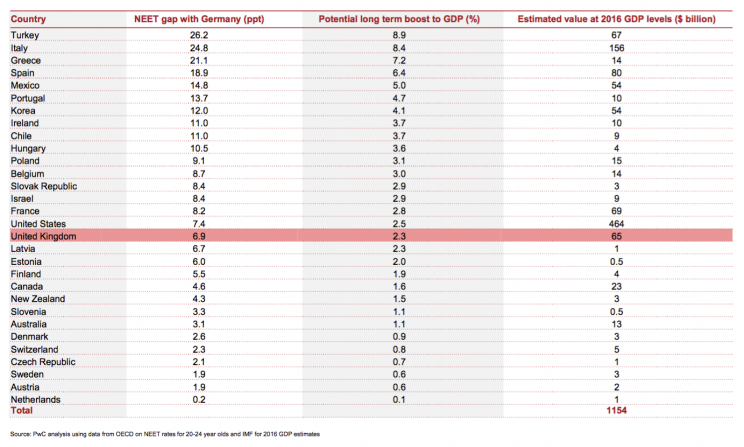Global economy could be $1.1T richer by following German youth employment model

Just 10.1 per cent of Germany’s young workers, between the ages of 20 and 24, are not in school or out of work.
That impressive figure places the country among the world’s leaders in youth employment.
And, according to a new report by PricewaterhouseCoopers, if all member countries of the Organization for Economic Co-operation and Development lowered their youth NEET rates (not in education, employment or training) to near German levels they could stand to gain about $1.1 trillion in gross domestic product across the board.
In Canada, where the NEET rate is 14.8 per cent, the long-term gain would result in a 1.6 per cent boost to the GDP.

The PwC report, entitled Young Workers Index 2016, also ranks OECD countries in terms of the conditions of their youth-labour markets.
Switzerland tops the list, with German and Austria trailing close behind. Canada placed 8th, two spots ahead of the United States.
Spain, Greece and Italy, finished at the bottom of the list in 32nd, 33rd and 34th respectively.
Canada has actually seen its young workers index score drop from a peak score of 63 10 years ago to 57 last year, while Germany jumped up from 58 in 2006 to 66 in 2011, where it remained in 2015.
Switzerland has consistently stayed atop the leaderboard since 2006.
The OECD average in 2015 was 48.2.

The report points to Germany as a model of success because, unlike many other countries, it managed to improve economic opportunities for young people after the Great recession.
“Governments could learn from other countries, such as Germany, who have engaged employers in order to introduce ‘dual education systems’ and focus on social inclusion in their youth policy,” authors David Tran, an economics and policy consultant, John Hawksworth, PwC’s chief economist, and Hannah Audino, an economist, wrote in the report.
By dual education system, the authors are referring to efforts that involve vocational training and classroom learning to give youth more options once they’ve entered the working world.
They suggest this should incorporate working with employers to offer apprenticeships, which is “key to preventing skill mismatches.”
“Businesses should play an active role in designing apprenticeships and being proactive around youth employability,” added the authors, pointing to early engagement strategies, such as providing career advice, mentoring, youth-led social action and work experience.
In Germany’s case, the report said that more than 50 per cent of students in its dual education system are funneled into one of more than 300 training occupations.
The government has also orchestrated the delivery of more than 500,000 company-based training contracts a year.
Other new initiatives have also given university dropouts the option of vocational training.
The report also indicates that the promotion of core skills, such as expertise in digital services and mathematics, as well as a focus on social inclusion on the part of governments, can go a long way in improving conditions for young workers.
Social inclusion is one area where Canada thrives, according to PwC.
The study points to several initiatives including:
The federal government’s Youth Employment Strategy, which aims to provide skills and advice for those facing barriers to employment;
Skills Link, which gives funding to employers and organizations so they can offer education and training, focusing on youth with disabilities, job seekers from single-parent or immigrant families and those living in remote areas;
And Canada Summer Jobs, which offers funding to employers to create opportunities when youth are off from school.
PwC stresses that youth unemployment is a vital issue that needs to be addressed, as in nearly half of all the OECD countries in 2005, one in four young people were out of a job for more than a year.
“We need to pay attention to this,” the authors wrote.

 Yahoo Finance
Yahoo Finance 
